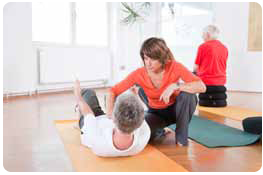
One of the most common causes of back pain, degenerative disk disease (DDD) occurs when intervertebral disks break down. Your spine is comprised of a column of bones called vertebrae, with gel-filled disks between them to absorb shock. Made up of about 80% water, these vertebral disks lose water as you age, causing them to shrink. This can lead to smaller space between disks, bone spurs, narrowing of the spinal canal, and tears in the annulus, the wrapping on the outside of the intervertebral disk that protects the disk’s soft center.
Not all individuals who have DDD will experience pain, although it is a common complaint. For those who do, the pain can be extreme enough to interfere with simple daily activities. Pain may start after an injury, or it may begin gradually and become progressively worse.
Treatments for DDD include surgical and nonsurgical modalities. Usually a last resort, surgery is considered only after attempts at nonsurgical methods do not bring relief.
Physical therapy, the “gold standard” treatment for DDD, can help you return to a full activity level again. Stretching and flexibility exercises will improve mobility and strength in the spine. Low-impact aerobic exercise can help with overall fitness, improve your stamina to help you get through your day, reduce the number ofepisodes of low back pain you experience and relieve the pain’s intensity when an episode does occur. Other approaches include
- proper lifting and walking techniques
- manual therapy to loosen stiff muscles and joints
- activity modifications to ease your return to movement
- lifestyle advice and occupational adjustment recommendations
- pain medication, muscle relaxants and ice to reduce inflammation
DDD can be very debilitating, more so when it is accompanied by significant pain. Fortunately, physical therapy has excellent outcomes, especially when started at the onset of the condition. By engaging in an individualized program of exercises that we design, you can experience relief and a full return to activities, mobile and free of pain.
